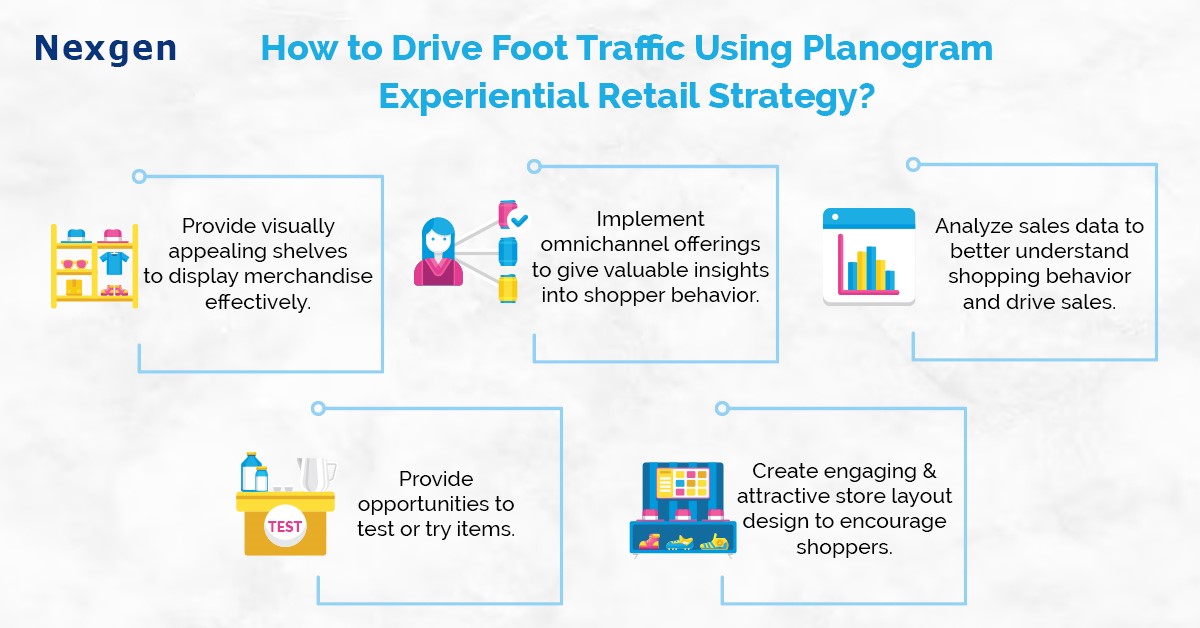When it comes to in-store shopping, the shopping experience counts just as much as the sale. You must provide customers with a compelling value proposition to convince them to visit your store when they can buy almost anything online. The future of bricks-and-mortar is not as a storehouse for your inventory, but a space for shoppers to be immersed in your brand identity and experience.
What is Experiential Retail?
In today’s retail, nearly 60% of customers expect shops to give experiences than just merchandise. Experiential retail is a marketing strategy where brick-and-mortar stores offer memorable shopping experiences beyond browsing or purchasing items. Such stores actively engage customers and entice them to visit the store by offering perks like in-store services or events or advanced visual merchandising solutions. Planograms are visual merchandising tools that assist retailers in effectively planning and executing store shelves. This aids retailers in designing and executing product displays to drive shopper’s attention and significantly increase sales.
Why Should a Retailer Invest in Experiential Retail?
After being disrupted by the pandemic, brick-and-mortar is making a big comeback to rule the retail world. According to reports, shoppers prefer to shop in physical stores rather than ordering online. Shoppers are raring to get back to stores for more reasons, such as the in-store experience, and curbside pickup, and they want to explore and be entertained by unique retailing. As shoppers become more selective about the brands or stores, they shop with, the in-store experience needs to stand out from the rest. Planogram in retail will help you deliver creatively enticing in-store experiences to shoppers. Stores from all over the world have now implemented experiential elements in their stores with the help of visual merchandising planograms. This blog will help you understand the benefits of experiential retail, and provide ideas and examples for you to try out to drive customer traffic using planogram strategies.

1. Implement omnichannel offerings: Your shoppers might enjoy shopping in physical stores, but it does not mean they are not using other channels to make their purchasing decisions. Customers are looking for brands that show their purpose and activate it through in-store experiences, such as store layout design, storytelling and proper product categories. Planograms help you present and display merchandise to catch a shopper’s attention and interest. This ensures that products are presented at their best, visually appealing to shoppers through creative product displays. You can improve customer satisfaction by providing smooth transitions between your online store experience and physical offerings. Analyzing such things will give you valuable insights into shopper behavior and how they want to engage with your brand.
2. Provide opportunities to test/try items: Most online stores do not have the option to test products before purchasing. Customers frequently prefer to visit actual stores for this reason. Customers can test out things through experiential shopping by using visual merchandising techniques. Retailers place samples near the actual products so customers can try them. For example, your shopper would not willingly buy a mattress without testing it first. This helps retailers entice shoppers and boost sales. Another example is, let’s say, your customer is looking for a new moisturizer. They have the choice of visiting two stores: one with a pick-off-the shelf approach, the other with different samples of moisturizer to try, where you can experience which moisturizer is suitable for your skin tone. Your customers will choose the store that gives them the best in-store experience. Implementing experiential elements such as in-store events and product demos can create a memorable and engaging shopping experience.
3. Ensure you have a good store layout design: Creating an engaging and attractive store layout will encourage shoppers to explore and interact with products. With the use of a planogram, you may continuously analyze sales data to better understand shopper’s buying behavior, demands, and preferences. The atmosphere of your retail space can enhance the shopping experience for customers. If you own a jewelry store, for instance, emphasizing scents, aesthetics, or lighting while showcasing your best-selling pieces can make customers feel welcomed and allured.
Overview of Nexgen POG
Nexgen POG is a robust and user-friendly cloud-based visual merchandising tool. It is designed for quick and efficient planogramming with minimal effort. Planogram in retail can be designed by easily dragging and dropping the products. The multi-device compatibility feature of POG allows you to obtain, share and edit planogram on any device, including your phone. It helps in designing store-specific planograms for increased product visibility and sales.
Get Your Free Trial Now!